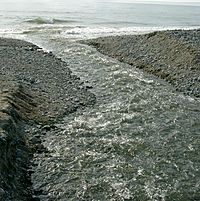Afon Clarach facts for kids
Quick facts for kids River Clarach |
|
|---|---|

Afon Clarach meets the sea at Clarach Bay
|
|
| Native name | Afon Clarach |
| Country | Wales |
| Region | Ceredigion |
| Physical characteristics | |
| Main source | Capel Dewi, Aberystwyth |
| River mouth | Clarach Bay |
The Afon Clarach (which means River Clarach in English) is a small river in Wales. It flows into Cardigan Bay, just north of the town of Aberystwyth.
This river winds its way through beautiful countryside. You'll see lots of farms and forests along its path. Closer to the sea, where the river ends, there are many holiday places.
Where Does the Afon Clarach Start and Flow?
The Afon Clarach actually begins when two smaller streams meet. These streams are called the Afon Stewi and Nant Seilo. They join together near a place called Penrhyncoch. Both of these streams start in low hills. These hills are on the edge of the Plynlimon mountain range.
As the river flows, it passes by some interesting places. One is the Institute of Biological, Environmental and Rural Sciences. This is a part of Aberystwyth University. The river also goes past the village of Bow Street. Between Bow Street and another village called Llangorwen, a small stream called Bow Street Brook joins the Afon Clarach.
What Lives in the Afon Clarach?
The Afon Clarach is home to several types of fish and other water creatures. Because the river flows into the sea over a beach at Clarach Bay, it can be hard for some fish to swim upstream. This means that fish like Atlantic salmon and sea-trout are not very common here.
However, you can often find other types of fish. These include brown trout, which are a popular fish in rivers. You might also spot brook lampreys, which are unique, eel-like fish. Other common creatures are millers thumb and stone loach. These are small fish that like to live on the riverbed.
Keeping the River Healthy
In the past, the upper parts of the Afon Clarach were affected by mining. People used to mine for lead and silver in the area. This mining caused some problems for the river's water quality.
Today, there are still some things that can affect the river's health. For example, some natural materials from farms can get into the water. Also, treated water from the Bow Street sewage treatment works is released into the river. People work to make sure these things don't harm the river too much.


